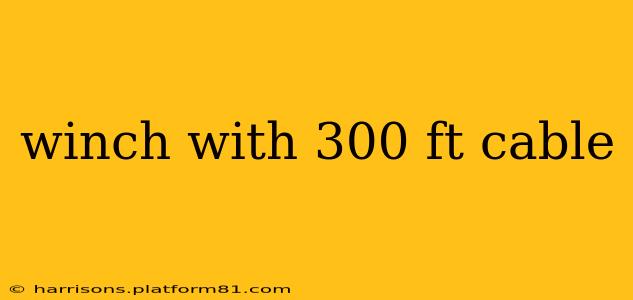Finding the right winch with a 300ft cable requires careful consideration of several factors. This guide will help you navigate the options and select the best winch for your specific needs, whether you're a professional contractor, an avid off-roader, or a homeowner with demanding tasks. We'll explore different types, capacities, and features to ensure you make an informed decision.
What are the different types of winches with 300ft cables?
Winches with 300ft cables are generally categorized by their power source and application:
-
Electric Winches: These are the most common type for various applications, offering convenience and ease of use. They are powered by a battery, usually 12V or 24V, and are ideal for vehicles and other motorized equipment. The 300ft cable length makes them suitable for extensive pulling or recovery operations.
-
Hydraulic Winches: These are powerful winches driven by hydraulic pressure, often used in heavy-duty applications such as construction, logging, and industrial settings. They offer superior pulling power compared to electric winches but require a hydraulic system to operate. A 300ft cable on a hydraulic winch indicates a large-scale operation.
-
Manual Winches: While less common with 300ft cables due to the strenuous effort required, manual winches exist. These are typically hand-cranked and used for lighter applications where electric or hydraulic power is unavailable or impractical.
What is the pulling capacity I need for a winch with a 300ft cable?
The pulling capacity, usually measured in pounds, is crucial. A 300ft cable implies a need for a significant pulling distance, so the capacity must be sufficient to handle the anticipated load. Underestimating this can lead to winch failure or insufficient pulling power.
-
Consider the weight of the load: This is the most important factor. The winch's pulling capacity should significantly exceed the weight of the object you intend to pull.
-
Consider the angle of pull: Pulling at an angle reduces the effective pulling capacity. Always factor this into your calculations.
-
Consider the terrain: Rough terrain increases friction and demands a higher pulling capacity.
What type of cable is best for a 300ft winch?
The cable material significantly impacts durability and performance.
-
Steel Cable: This is the most common type, offering high strength and durability but can be susceptible to rust and damage.
-
Synthetic Rope: Synthetic rope is lighter, less prone to damage, and easier to handle than steel cable. However, it may have a lower breaking strength than steel cable of the same diameter.
How do I maintain a winch with a 300ft cable?
Proper maintenance is crucial for longevity and safety:
-
Regular Inspections: Check the cable for fraying, kinks, or damage. Replace the cable if necessary.
-
Lubrication: Regularly lubricate the winch's moving parts to prevent wear and tear.
-
Storage: Store the winch in a clean, dry place to protect it from corrosion.
What safety precautions should I take when using a winch with a 300ft cable?
Safety is paramount when using a winch with a 300ft cable:
-
Use appropriate safety gear: Wear gloves, safety glasses, and sturdy footwear.
-
Proper anchoring: Ensure the anchor point is secure and capable of withstanding the winch's pulling capacity.
-
Never exceed the winch's rated capacity: This could lead to serious injury or equipment damage.
-
Be aware of your surroundings: Avoid operating the winch near people or obstacles.
What are some common applications for a winch with a 300ft cable?
A winch with a 300ft cable finds applications in:
-
Off-road recovery: Pulling vehicles stuck in mud, sand, or snow.
-
Construction and heavy lifting: Lifting and moving heavy materials on construction sites.
-
Logging and forestry: Pulling logs or other heavy materials through difficult terrain.
-
Marine applications: Anchoring boats or recovering equipment.
Choosing a winch with a 300ft cable involves careful consideration of several factors. By understanding the different types, capacities, and safety precautions, you can select the right winch for your specific needs and ensure safe and efficient operation. Remember, always prioritize safety and consult with a professional if you are unsure about any aspect of winch operation.
